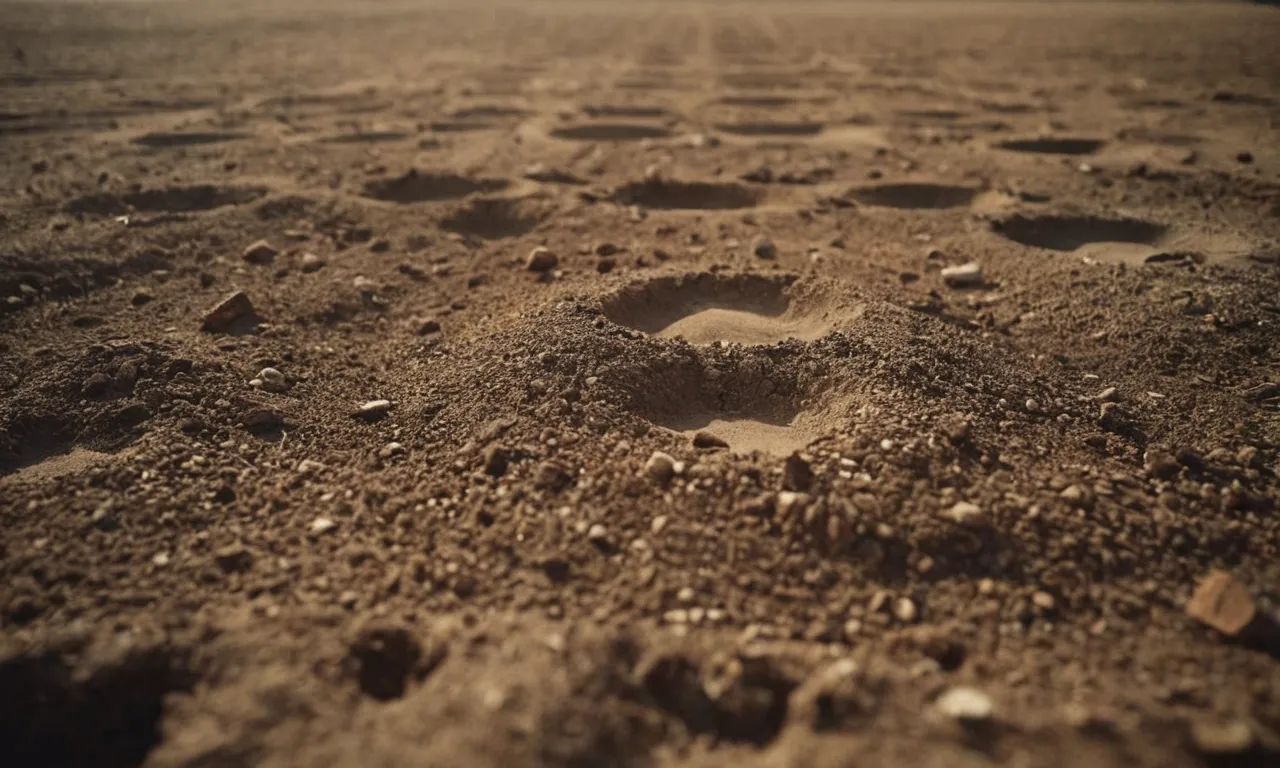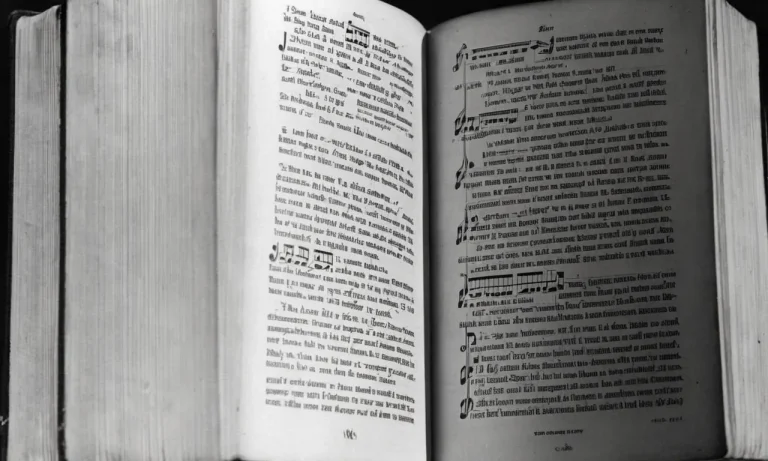What Did Jesus Write On The Ground? A Detailed Examination
The story of Jesus and the adulterous woman in John 8 has intrigued people for centuries. In particular, the verse “Jesus stooped down, and with his finger wrote on the ground” (John 8:6) has captured people’s imagination regarding what exactly Jesus wrote.
If you’re short on time, here’s a quick answer: While the Bible does not specify what Jesus wrote, theories include listing the accusers’ own sins, a quote from Jeremiah, the Ten Commandments, or simply doodling to buy time.
In this approximately 3,000 word article, we will analyze the biblical context, historical interpretations by theologians and scholars, artistic depictions, and potential symbolic meanings to comprehensively examine the question surrounding those mysterious words in the dirt.
The Story of the Adulterous Woman in Context
The Account in John 8:1-11
The well-known story of Jesus and the woman caught in adultery is found only in the Gospel of John (8:1-11). This dramatic encounter begins with the scribes and Pharisees bringing a woman caught in the act of adultery before Jesus, wanting to stone her as the Mosaic Law commanded (Leviticus 20:10).
Jesus stoops down and begins writing on the ground with his finger, rising to say “Let him who is without sin among you be the first to throw a stone at her.” He then stoops again to resume his writing. As the woman’s accusers depart one by one, Jesus asks if any of them have condemned her.
When she replies no one, Lord, Jesus says “Neither do I condemn you; go, and from now on sin no more.”
This passage has been the source of much debate over why Jesus wrote on the ground. While the text itself does not say what he wrote, theories abound. Perhaps he listed the sins of the woman’s accusers? Or quoted Scripture passages about adultery and forgiveness?
Though we cannot know for sure, reflective readers over the centuries have found meaning in Jesus’ simple but profound action of writing reflectively at this dramatic moment.
Examining the Wider Context
Looking at the broader context of John’s gospel gives us insight into this scene. John highlights how Jesus interacted with women in counter-cultural ways, like his lengthy discourse with the Samaritan woman at the well (John 4).
He elevated their dignity and offered them mercy, as we see poignantly demonstrated with the adulterous woman.
The motif of Jesus writing also occurs a few chapters earlier in John’s gospel, when Jesus heals a blind man by making clay with saliva and telling him to wash in Siloam, which means “Sent” (John 9:6-7).
This connects to Jesus frequently describing himself as One “sent” from the Father, reminding readers of his divine origin and mission. His writing on the ground likewise carries symbolic connotations of his authority and identity.
Regarding the Mosaic law prescribing capital punishment for adultery (Leviticus 20:10), later rabbinic tradition stipulated very specific evidence requirements before such a sentence could be imposed.
Jesus may simply have been highlighting that the legal process was not duly followed in this woman’s case.
Most intriguing is how this story is connected to the later crucifixion scene, when Jesus declines wine mixed with myrrh to dull his pain (Mark 15:23), choosing instead to drink the “cup” of suffering prepared for him by his Father to its fullest.
Likewise, Jesus protected the condemned woman from experiencing the cup of unjust wrath her accusers wished to pour on her.
Proposed Theories on What Jesus Wrote
Listing the Accusers’ Sins
One popular theory is that Jesus wrote down the sins of the woman’s accusers. This view holds that He likely wrote them in the dust so they would blow away, symbolizing forgiveness. Writing a list of sins would have exposed the hypocrisy of the accusers, since they too were sinners.
Jesus may have written well-known sins of the religious leaders to prick their consciences and highlight their own need for grace (John 8:7). This powerfully illustrates that we should not judge others harshly when we too are imperfect.
Quoting Jeremiah 17:13
Some believe Jesus was quoting Scripture, specifically Jeremiah 17:13: “Lord, the hope of Israel, all who forsake you will be put to shame. Those who turn away will be written in the dust because they have forsaken the Lord, the spring of living water.”
By quoting this verse, Jesus was calling out the accusers for rejecting Him, the Messiah. Just as their names would fade in the dust, so would their rejection of the Lord. This reminds us that turning from God leads to shame, while embracing Jesus brings eternal life.
Writing the Ten Commandments
Another view is that Jesus wrote the Ten Commandments in the sand, convicting the woman’s accusers of their own disobedience to God’s laws. The accusers wanted to stone the woman for adultery but were not keeping the commandments themselves. As sinners, the Pharisees had no right to condemn others.
Writing the commandments reminded them that no one perfectly obeys God’s laws. We all need grace and should be slow to judge others.
Simply Doodling to Buy Time
Some believe Jesus’ writing had no special meaning. He may have simply been doodling in the dirt to buy time before responding. This view sees Jesus’ stooping down as a tactful pause to diffuse the volatile situation before lifting up and uttering His famous words, “Let any one of you who is without sin be the first to throw a stone at her” (John 8:7).
His thoughtful delay highlights that we should also be cautious in passing judgement and careful with our words.
Artistic Depictions Throughout History
The scene of Jesus writing on the ground while confronting the mob who wanted to stone the adulteress has captivated artists for centuries. Though the Bible does not specify what Jesus wrote, many artistic interpretations have tried to visualize this mysterious moment.
Some of the earliest known depictions are found in illuminated manuscripts from the Middle Ages. These miniatures often show Jesus crouched down writing with his finger, while the woman accused of adultery kneels beside him surrounded by her accusers.
The varied speculations about Christ’s writing include games, names of the woman’s lovers, and passages from the Old Testament. Renaissance masters like Rembrandt, Botticelli, and Blake offered their own imaginative renderings of the scene with Jesus pensively scratching on the ground.
Modern interpretations continue this tradition of creative license. Salvador Dali’s surrealist version has Jesus scribbling geometrical shapes, while contemporary artists like James Tissot visualize Hebrew letters or stick-figure doodles.
Some feminist readings show Christ writing words that challenge the double standard applied to women’s morality. While these depictions take artistic liberty, they reflect the profound intrigue surrounding Christ’s unrecorded words.
Attempts to actually decipher the content range from Chrismatic symbols to passages from Deuteronomy advocating mercy over judgment. But the mystery has endured over two millennia. Regardless of the speculative contents, artistic mediums remind us of Jesus’ silent yet powerful witness that saved the woman from condemnation that day.
Symbolic Meanings and Spiritual Interpretations
The act of Jesus writing on the ground in John 8 has been interpreted symbolically and spiritually throughout history. Here are some of the common meanings ascribed to this enigmatic event:
Jesus as the New Lawgiver
Many see Jesus’ writing as symbolic of him bringing a new law to replace the old law of Moses. Just as God wrote the Ten Commandments with His finger, Jesus writes the law of grace and truth. This contrasts with the Pharisees who were trying to condemn the woman according to the old law.
Jesus Writing Men’s Sins
Some suggest that Jesus was writing down the sins of the woman’s accusers, exposing their own hypocrisies and lack of righteousness. This view is supported by how after writing, Jesus tells them “Let any one of you who is without sin be the first to throw a stone at her.”
Jesus Forgiving Sins
Others believe Jesus may have been writing words of forgiveness towards the woman, offering her grace and removing her guilt. This is connected to Jesus’ words “Then neither do I condemn you” to the woman after the crowd leaves.
Jesus Delaying Judgement
A common explanation is that Jesus was simply stalling and writing meaningless symbols, delaying judgement to give the accusers time to reflect on their motives and leave. This emphasizes Jesus’ mercy even in the face of the law.
Jesus Affirming His Deity
Some commentators suggest Jesus was writing declarations of his divine identity as the Son of God. This surprised the Pharisees who then felt convicted and departed. This ties into later declarations by Jesus that “I and the Father are one.”
In the end, Jesus writing on the ground remains an intriguing mystery. Whether he wrote laws, sins, forgiveness, or affirmations of deity, the act highlights Jesus’ mercy and wisdom in the face of the legalistic traps of the Pharisees.
The Enduring Mystery and Its Implications
The story of Jesus writing on the ground in John 8 has intrigued people for centuries. Yet, despite much speculation, the meaning behind his enigmatic action remains elusive. This enduring mystery surrounding what Jesus wrote has significant theological and practical implications.
Theological Implications
On a theological level, the mystery invites reflection on Christ’s identity. As the incarnate Son of God, Jesus demonstrated divine wisdom and insight in his response to the woman caught in adultery. The content of his writing likely communicated truth on a profound spiritual plane not accessible to the carnal minds surrounding him.
His action also reminds us of Old Testament passages that speak of God writing his law on our hearts (Jeremiah 31:33). Just as we cannot know exactly what God writes on our hearts, so too we cannot pierce the veil on what Christ penned in the dirt.
In addition, the mystery points to the inscrutability of God’s ways. As finite beings, we can never fully comprehend the infinite mind of Christ. There is an unfathomable depth to his character. As Isaiah 55:8-9 states: “For my thoughts are not your thoughts, neither are your ways my ways, declares the Lord.
For as the heavens are higher than the earth, so are my ways higher than your ways and my thoughts than your thoughts.
” Jesus’ writing remains enshrouded in obscurity because of the transcendence of his intellect and wisdom.Practical Implications
On a practical level, the enduring mystery invites us to humility and teaches several valuable lessons. Firstly, it cautions us against overly speculative theology. Since we do not definitively know what Jesus wrote, we would do well to avoid dogmatism.
There is an element of holy ground here that should be approached with reticence. The obscurity also reminds us of the limits of human insight compared to Christ’s supreme knowledge and comprehension.
Secondly, the mystery points us to focus on Jesus’ clear actions and words rather than extrabiblical conjectures. Scripture unambiguously narrates his gracious pardon and command to the woman. We can grasp these realities without unraveling what he penned.
Lastly, the cryptic writing prompts meditation on the portions of God’s Word we do possess. There are depths to Scripture waiting to be mined that require lifetimes to exhaust. If the brief, unrecorded words of Christ warrant so much curiosity, how much more the lengthy revelation he has already given?
While speculation will undoubtedly continue, the pages Jesus marked that day will likely remain forever sealed. And therein lies the abiding lesson – no matter how intently we peer at the lines in the sand, the Son of God reserves prerogatives of wisdom to himself alone.
Though veiled in mystery, his writing still signals the unfathomable grace that stooped to forgive and liberate a condemned woman. For this clear message we can be eternally grateful.
Conclusion
While the Bible gives no definitive answer on what Jesus wrote that day, the mysterious act has inspired many interpretations over the centuries. More important than the words themselves was Christ’s lesson in mercy triumphing over judgment.
The story remains an entry point for discussing sexual ethics and social justice. And the image of Jesus quietly writing as an angry mob rages invites us to ponder and emulate his wisdom, patience, and compassion.








